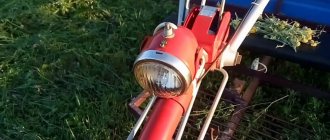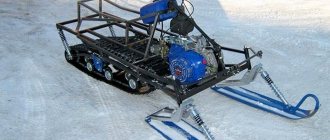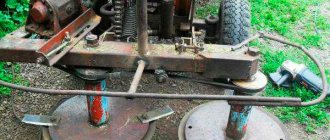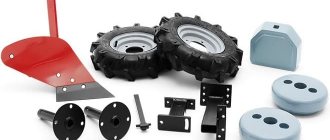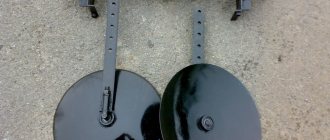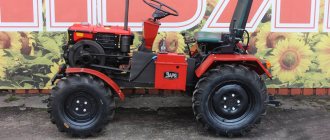Do-it-yourself trailer for a walk-behind tractor. Device
The design is formed by a frame and a body. Do-it-yourself home-made trailers for a walk-behind tractor imply a metal frame. If wood is taken as the starting material when obtaining a frame element, then there are several negative consequences when using this material:
- due to the moisture content of the wood, shrinkage and twisting of the elements will occur, which will lead to frequent repairs;
- the service life is very short, as the tree is exposed to moisture, insects, ultraviolet rays;
- the bending strength of the tree limits the trailer's load capacity.
It is easier to use profile pipes for mounting the frame. They are characterized by good rigidity and lack of tendency to compress when exposed to gravity. When using bolts for fastening, sheathing will be easier. The material for sheathing is selected at will: iron, corrugated board, boards.
hitch
Do-it-yourself trailer dimensions for a walk-behind tractor are selected according to the dimensions of the pipes. A standard trolley will require pipes 50 (60) x30 (frame) and 25x25 (racks) in size. Channel will fit number 5. Various materials are suitable for lining the trolley. The bottom of the trailer must be thicker to avoid the occurrence of deforming reactions. The strength of the structure is provided by the upper strapping of the racks. As an axle for wheels, a base of a metal nature or a beam that was used on some technique is used. The smallest diameter of the axis is 3 cm. It is necessary to mount the corner and kerchief zones to strengthen the support. The wheels of the trolley can be wheels from a Zhiguli or a motorcycle. The use of wheels of a motorcycle sidecar CZD will contribute to obtaining a hub for a motoblock trailer. The hub component is fixed by pressing. Its end is bored and placed on the axial segment so that there is no distortion. The trailer is attached to the walk-behind tractor with a hitch. A simple execution is considered the "pipe in pipe" method. A bent pipe serves as the basis. A small piece of pipe is attached to it during welding. Then the connecting pin is installed. On the other side of the curved part, a pipe section and a kingpin are installed. The described do-it-yourself hitch for a walk-behind tractor contributes to the reliability of fastening and mobility when cornering.
Do-it-yourself adapter for a walk-behind tractor. Types of adapters for walk-behind tractor
The adapter looks like a trailer with two wheels and a driver's seat. This design allows you to automate and facilitate all work processes. If you want to make an adapter for a walk-behind tractor with your own hands, first the owner should decide on the optimal choice of one of the existing types of devices. The device, depending on the type of transmission, can be articulated:
- helmsman;
- mobile;
- The location of the main power plant allows you to make the adapter: front or rear.
steering adapter
The device of this design is based on a rigid joint with a mechanized means, while the steering is implemented as a separate unit. In this case, the steered wheels can be rear or front - the choice is up to the designer.
A self-made trailer with steering makes the walk-behind tractor a self-sufficient machine with good running and easy operation
Articulation Adapter
The variant with a movable joint is based on changing the angle with respect to the vertical axis located between the connecting elements.
It is easier to assemble this design, but it should be borne in mind that when cornering, more forces will have to be applied
Front and rear adapters
Depending on the design, the adapter can be:
- front - to be in front of the controlled walk-behind tractor;
- rear - fastened at the back.
The choice of placement, to a greater extent, depends on the purpose of use:
- for digging and loosening processes, the front adapter will be more convenient;
- for jobs requiring visual control, such as hilling, the rear adapter option is the best option.
Auxiliary equipment for walk-behind tractor
Among the necessary improvements to the walk-behind tractor in the form of attachments, it is recommended to make, in addition to all of the above, the following elements:
- wheels with lugs for working on loose soil;
- lift;
- mounted bucket-blade for snow removal.
Wheels with rubber tires are used for wheel designs used as movers of a walk-behind tractor on arable land. How to make wheels for a walk-behind tractor with lugs yourself will be prompted by experience and the ability to work with ready-made structures, for example, with steel rims from car wheels.
For this you need:
- 2 steel discs from a car;
- corners 25x25 cm;
- electric welding;
- Bulgarian;
- tape measure and pencil.
The corner is cut into segments of 35-40 cm. The disc rims are marked into equal segments. It is best if there are 8 or 10 of them. Marks are made and corners are welded at the marks.
It is better to make a do-it-yourself lift for a walk-behind tractor from a piece of pipe with a diameter of 100 mm. The lift itself is made in the form of a roller on the bracket. If necessary, it changes its position and makes it possible to raise the walk-behind tractor to the support. In the normal position, the lift shaft is located in front of the unit and is used as a track roller when overcoming ditches and potholes.
It is recommended to assemble a do-it-yourself bucket for a walk-behind tractor if you plan to use it as a snowplow.
Bucket can be made:
- from sheet metal 1.5-2 mm thick;
- hard plastic with a knife at the bottom of a metal strip;
- from plywood 8-10 mm thick or OSB board 10-12 mm.
The bucket is rigidly fixed on the frame of the walk-behind tractor. To facilitate the work, you can make a rotary device to change the angle of inclination of the cutting plane to the road surface.
In order for the bucket to work for a long time, a supporting ski is carried out in front on the bracket. This will make cleaning safer. The cutting surface will be at a certain height above the ground and not touch the ground.
It is possible to improve home motorcycle equipment to suit your requirements without high costs. After all, attachments for a walk-behind tractor can be assembled independently, having done everything with your own hands.
Read also: Depth of plowing under potatoes with a walk-behind tractor
The work of a walk-behind tractor with attachments - video
A walk-behind tractor is a device that will be useful both on a large plot and on a relatively small land area. With it, you can perform ordinary agricultural work many times faster than manually - thus, even one person can easily cope where a group of people was previously needed. However, each type of work requires its own attachments, which have a limited life span and periodically need maintenance and replacement. Sometimes it is easier to make attachments for a walk-behind tractor with your own hands than to buy it in a store - it all depends on the skills of the owner of the mechanism and his needs.
For those who do not know, you need to explain - with the help of a walk-behind tractor, you can remove snow, sow potatoes, prepare the soil for planting something in it, and perform other types of work. To do this, additional modules are attached to the main mechanism, thanks to which it can perform the operations described above. Do-it-yourself attachments for a walk-behind tractor will also come in handy if you need several of its units at once - then the cost of buying in a store can really be considerable.
Attachments for heavy walk-behind tractors. Do-it-yourself flat cutter for a walk-behind tractor
To cut the rhizomes of weeds, to loosen the soil to a shallow depth without turning the formation, nozzles such as flat cutters can. A flat cutter for a walk-behind tractor is quite simple to manufacture. For him you will need:
- sheet 5 or 6 mm thick;
- sheet 2 mm thick;
- profile pipe 40x40 with a wall of 3 mm.
The procedure for manufacturing this homemade attachments:
- A rack is cut out of a thick sheet according to the template. Mounting holes are drilled on the rack.
- A flat cutter's paw is cut out of a thin sheet. According to the template on the anvil, the paw is bent according to the drawing. The flat cutter element is assembled with rivets or welded into a single unit.
- Frame blanks are cut out of the profile pipe to fix the working body. The scheme of raising and lowering the frame is being worked out. Next, the hitch is welded, on which elements of flat cutters will be installed in the future.
- A scheme is being made for linking attachments to a walk-behind tractor. The received data is transferred to the frame. Plates are made to fix the hitch. Functionality is checked for lifting and lowering. All products are painted with 2 in 1 primer-enamel for corrosion protection.
Attachments are tested in the field. If necessary, adjustments are made to improve performance.
Homemade rototiller
Consider in this paragraph articles on how to make an active rototiller with your own hands. It is this type of the whole variety of rototillers that is the easiest to manufacture.
The very process of assembling a hand-held cutter looks like this: during tillage, the wheels are removed to move the entire walk-behind tractor due to the rotation of the cutter. The working paws, thanks to the rotational movements of the cutters, loosen the ground. The material for the manufacture of the cutting element and steel, you can choose steel strip with a diameter of 0.5 cm or more. It is recommended to sharpen the working paws in order to reduce resistance during the work process.
Before you prepare the knife, you need to sharpen the strip so that it can bend 90 degrees. The length of the bent part most often does not exceed 8 cm. It is more expedient to cool the workpiece together with a vacation for drilling mounting holes. After finishing with the hardening process, the last step is to install the axial tube on the flange.
Before starting work, study the diagrams and drawings thoroughly.
Also, do not forget that theory should always be fixed in practice. Therefore, we recommend watching a video on assembling a rotator with your own hands for a walk-behind tractor. This video can be used as a proper step-by-step instruction for a homemade rotator.
Motoblock homemade to him. Homemade products and accessories for a walk-behind tractor. New Versions
Very often, the acquisition of a walk-behind tractor is due to the performance of a single task, but over time, its owner has a desire to make his equipment universal. Many are wondering what can be done from a walk-behind tractor to improve it. In fact, there are a large number of craftsmen who can adapt anything to other instruments: the main thing is to have certain technical skills for this, combined with creative ingenuity.
Motoblock device
Such units have a common principle of operation and are equipped with a carburetor internal combustion engine (more powerful models may have a diesel power plant), a transmission and a pair of drive wheels. The control system of equipment in the form of rods and levers is placed on the steering wheel. There are also models equipped with a differential.
Maintenance of equipment is no different from automotive, with the exception of some design features of walk-behind tractors.
The feasibility of homemade
Although there is a greater variety of attachments on the market, they may not always be suitable for certain tasks. And the price-quality ratio sometimes leaves much to be desired. Therefore, many gardeners-gardeners make the necessary accessories for walk-behind tractors with their own hands. To do this, it is enough to have a drill, a grinder and a welding machine at hand, as well as to have the skills to work with them.
Only in some cases, when more accurate calculations and turning work are needed, one has to turn to highly specialized specialists.
A plus in the direction of homemade products is the fact that at any disassembly you can easily find the necessary unit or unit from an old car, suitable for construction.
mini bulldozer
You can turn a walk-behind tractor into a miniature bulldozer capable of leveling small areas or removing snow and debris by installing a shovel blade on it. To do this, use sheet metal with a thickness of at least 3 mm. The lower part of the shovel should be slightly bent forward with respect to the common plane, a strip of dense rubber should be fixed on it for snow removal or sheathed with tin (for earthworks). To strengthen the entire structure at the back, it is necessary to weld several stiffeners from a metal corner.
Self propelled rake
Despite the presence of factory rakes, many farmers prefer to make them themselves, taking into account the characteristics of their farm: the size of the meadow, the relief.
Metal pipes and hardened rods are used as materials for the rake. But as an option, you can use the factory manual forks by welding them to the base. For the convenience of work, it is desirable to install small wheels or paws-skis along the edges, which will relieve the load on the entire structure.
Farming accessories
For cultivating the land, craftsmen have developed a number of devices that are superior in quality to factory products.
Most often, a do-it-yourself plow is used as a fixture for a walk-behind tractor, since factory prices are quite high. For its manufacture, sheet iron with a thickness of at least 4 mm should be used, from which the knife itself and pipes with walls of the same size are cut directly, for the frame and fastening.
hiller
A device for hilling beds can be made of two metal disks.
They must be the same size with a diameter of at least 50 cm. It is advisable to pre-sharpen the edge of the disks for better soil intake. Mounting them on the frame should be thought out so that it is possible to change the distance between the disks in accordance with the width of the beds.
You can also consider new versions of various devices that facilitate the work of caring for the garden as homemade products for the walk-behind tractor:
- cultivators;
- cutter;
- knives and flat cutters.
Their drawings can be easily found on the Internet and taken as the basis for a future product.
Homemade for walk-behind tractor
The question of where to start designing attachments for walk-behind tractors is quite reasonable. The fact is that almost all walk-behind tractors are equipped with factory-made towing devices, designed for the use of standard types of equipment. It should be clarified that it is the standard equipment that does not satisfy the needs of customers - the trailing systems turn out to be too delicate and fragile when used in harsh operating conditions.
For domestic walk-behind tractors, trailers are mainly made of steel by welding, but for mass Chinese production, this is mainly cast iron, or an alloy of metals. It is clear that even the most powerful cast iron adapter will not withstand for one hull plow.
Because the first thing you need to create is do-it-yourself trailer to a walk-behind tractor for a plow. Here, it is better to take the standard scheme as the basis for the design - the adapter is a hinge with the ability to fix the plow in different positions, which is especially convenient for plowing small areas when a plow is used with both left and right blades.
The adapter itself is recommended to be made with the possibility of fixing not only in the vertical, but also in the horizontal planes with the help of lanyards and bolted connections.
This option will help to use it for plowing, and for hilling, and for installing an adapter-seat for a mower or rake for turning hay in a hayfield.
Universal trailer for motoblock
The presence of a trailer provides mobility, because it is one thing to drive a walk-behind tractor with units already installed, and another when a plow, cutter or potato planter is simply loaded onto a trailer and transported by the walk-behind tractor itself.
It is necessary to calculate the parameters of trailed equipment for a walk-behind tractor based on its power, the principle here is simple - 1 liter. With. means the possibility of transporting 100 kg of payload on a trolley. The simplest and most reliable is the scheme of a single-axle trailer with a load on the central axle. And although the carrying capacity of such a trailer is small, only up to 500 kg, this is quite enough to install a seat on the trailer and control the walk-behind tractor while sitting on the trailer.
The most difficult thing here is to find the necessary components. The easiest way is to use ready-made parts. For example, a do-it-yourself hub for a walk-behind tractor is made from an automobile one, for cars. This allows the use of standard automotive wheels and tires for the equipment of the unit. On the other hand, the hub from the VAZ classics is also perfect for making other useful homemade products - lugs, winches, wheel weights.
For the trailer, a rectangular pipe structure is mainly used, but both a channel and an I-beam can be used as a frame base. It is better to provide the sides for the trailer with removable ones. It is preferable to immediately provide for the possibility of installing several types of boards on the platform:
- wooden or metal for transportation of bulk cargoes;
- light, mesh for harvesting green mass for animals;
- folding, with the possibility of increasing the usable area for transporting hay.
But in order to make it comfortable to move along the roads, it is worth making wings on a walk-behind tractor. If possible, immediately install mudguards on them. After all, not all roads have asphalt and hard surface.
A walk-behind tractor with a trailer cannot be called a vehicle according to the law today, but this does not mean that the trailer should not be equipped with light signaling.
Be sure to install at least 4 reflective elements on the trailer - 2 red at the rear and 2 white at the front. This will help the driver of the car to identify the wagon in the dark.
See also: wood drill bit
Soil tillage tools - do-it-yourself plow and plow for a walk-behind tractor
Before you make a hitch on a walk-behind tractor for tillage, you should decide what is more important and prioritize the technique of cultivating the site. For large areas used for planting potatoes, root crops, crops, the best option would be a do-it-yourself plow for a walk-behind tractor. Make it simpler and easier. But for beds for vegetable crops, for processing strips between rows of a garden or for final processing for planting, it is better to make a cutter. This will make future work much easier.
With a ready-made hitch to a walk-behind tractor, the most difficult thing to manufacture a plow is its shape. The body has a shape that is difficult to mold and therefore it is better to make a plow from several components. Do-it-yourself coulter for a walk-behind tractor is best made of steel. The large force that this element will experience should not lead to its deformation. Moreover, it is the coulter that is responsible for the depth of lowering the plow.
The plowshare should be made of the hardest possible metal. This is the part of the plow that cuts into the ground and cuts its layer. The strength and power of this element will allow you to work with the plow both in the conditions of cultivated arable land, and to do preliminary processing of virgin soil. Despite the complexity of the blade design, it is quite simple to make it. For a curved blade, it is better to take a ready-made round or oval blank. From it, according to the drawing, make a dump. For this, craftsmen usually use large pipes from 350 mm in diameter or gas cylinders. In this case, the dump is obtained in an almost ideal shape.
One of the questions on how to make a plow for a walk-behind tractor will be the manufacture of a field board - a stabilizing element for a plow that sets the direction of its movement when working on arable land.
Do-it-yourself plow for a walk-behind tractor, just like a plow, is assembled from several elements. True, for the use of plows in tillage, it is better to provide for a blade of reinforcement, so that during processing the soil is loosened as much as possible when the formation is turned. In the design of the plow, it is better to provide not for a front blade, but for a double-sided blade with reinforcing bars.
Do-it-yourself cutter for a walk-behind tractor
Attached equipment for a walk-behind tractor in the form of a soil cutter can be used mainly for light and medium units. For heavy models with a separate power take-off and torque transmission to trailed units for a walk-behind tractor, chain cutters will be optimal.
The simplest cutters for loosening the soil can be four segment reciprocating cutters. Structurally, such a cutter is a pipe on which reciprocating cutters are rigidly planted. For medium and light units, the axle shafts for the walk-behind tractor are made collapsible. So you can adjust the width and speed of tillage. If two segments are installed on each side of the gearbox, then the processing speed is significantly higher. True, the width in this case will be small. For axle shafts of two or even four elements, the working width can be increased up to 1.5 meters.
Do-it-yourself mounted units for a walk-behind tractor are made from a profile pipe. The profile is easier to install on the wheel reducer. Yes, and to articulate them when building up is much easier and easier.
Simply insert them into each other and secure with studs. Do-it-yourself semi-axes for a walk-behind tractor are made of a square or hexagonal pipe with thick walls. For 1 set of cutters you will need:
- pipes for the axle housing with a wall thickness of 2.5-3 mm and a length of 50-80 cm;
- for connecting pipe segments of smaller diameter with a length of 50-60 cm;
- 8 reciprocating elements for the working body;
- clamps on the axle shafts - 4 pieces;
The cutters themselves are recommended to be made from a steel strip with a thickness of 5 mm or more. The best solution for the manufacture of milling cutters is the use of forged metal. In this case, the strength is higher and there is no need to frequently sharpen the tool. It is recommended to use drawings of the most successful models - reciprocating, curved, or cutters with a triangular pointed element when developing the shape of a cutter for a walk-behind tractor.
Disc cultivator for walk-behind tractor
One of the most popular types of attachments for a walk-behind tractor during the care of plants in the summer is a cultivator. Do-it-yourself weeder for a walk-behind tractor can be done:
- following the example of a classic cultivator in the form of a trailed ripper;
- in the form of disk hillers used for processing root crops.
The processing technology provides for the passage of a walk-behind tractor between two rows of crops or when using a multi-body cultivator of three or even four rows.
The cultivator okuchnik can have several types of tools installed in one housing:
- ripper;
- two double-dump plow-flat cutters;
- 2 disc harrows for the formation of ridges;
- two discs for plant protection.
Do-it-yourself plant protection discs for a walk-behind tractor are usually made of sheet steel. Depending on the purpose of the device to which they will be applied, their diameter is calculated. For cutters, usually the diameter is 5-7 cm smaller than the cutters, and for a cultivator, they should be 30-35 cm in diameter. It's just that during milling, the plants usually have a small height. But cultivation is carried out when the plants reach significant growth, and breaking them at this stage may result in the death of the vegetable crop.
Medium-sized discs can also be universal, with a diameter of 20-25 cm. In this case, it is necessary to provide for a universal type of attachment to each type of attachment.
